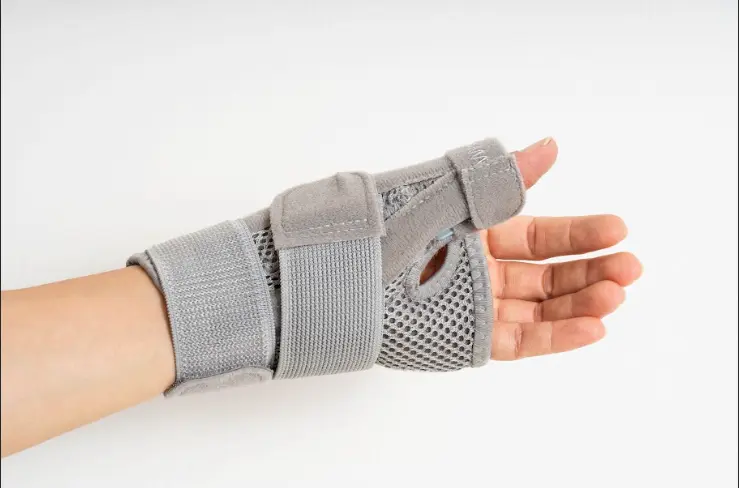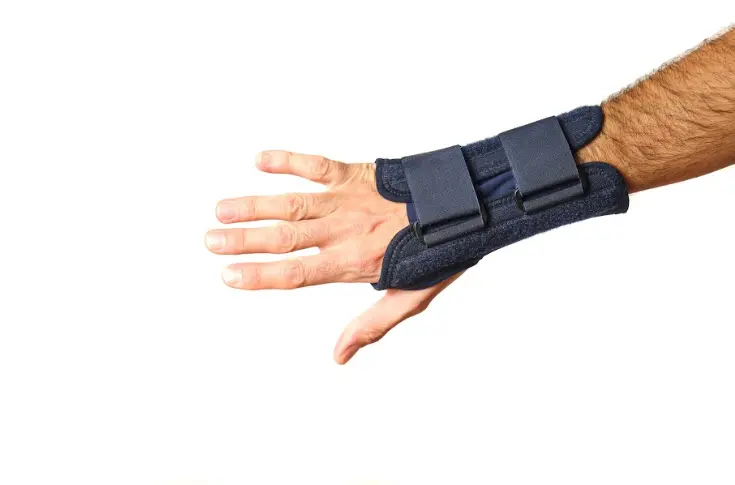If you’re experiencing wrist or hand pain from injury, arthritis, or carpal tunnel syndrome, a wrist brace can make a huge difference in your comfort and recovery. Also known as a wrist hand orthosis, this support device helps stabilize the wrist, reduce strain, and aid healing, especially while sleeping.

Carpal tunnel syndrome, for example, occurs when swelling in the carpal tunnel puts pressure on the median nerve, causing tingling, numbness, and weakness in the hand and forearm. Wearing a carpal tunnel wrist brace at night can help keep your wrist in a neutral position, reducing symptoms and preventing further damage.
What is a Wrist Brace (Wrist Hand Orthosis)?
A wrist brace, medically known as a wrist hand orthosis (WHO), is a device designed to support and immobilize the wrist, hand, and sometimes the fingers. It’s used for recovery after injury or surgery, and for managing conditions such as:
- Carpal tunnel syndrome
- Tendonitis
- Wrist sprains and strains
- Fractures
- Osteoarthritis and rheumatoid arthritis
- Post-operative care
- Ligament injuries
- Dislocation
- Radial and or Ulnar Fracture
- Cerebral Vascular Accident (CVA)/Stroke
Best Materials & Features for a Comfortable and Supportive Hand Brace
When choosing a hand brace, the right materials and features make all the difference in comfort, support, and healing. Here’s what to look for:
Materials Used in Hand Braces
1. Plastic Materials
Plastic braces can be heated and moulded to match your hand’s exact shape. This allows for a perfect, customised fit and provides strong, targeted support for faster recovery.
2. Carbon Fibre
Lightweight yet incredibly strong, carbon fibre braces offer firm support without adding bulk. This makes them more comfortable and easier to move in, especially when mobility is permitted during recovery.
3. Fabric and Straps
Soft fabrics with adjustable straps provide breathability and comfort. These are common in ready-made braces or for softer support needs, offering light to medium stability.
Adjustability for a Perfect Fit
1. Adjustable Straps
Velcro closures or buckles allow you to easily adjust tightness based on swelling or changing support needs.
2. Moldable Parts
Some braces include sections that can be heated and reshaped by a healthcare professional, ensuring a precise fit as your hand heals or as your needs change.
Comfort Matters
Wearing a brace for long hours means comfort is essential for consistent use.
1. Built-in Padding
Soft padding in pressure-prone areas prevents skin irritation and makes extended wear more comfortable.
2. Breathable Fabrics
Materials that allow airflow and wick away sweat help keep your hand cool and dry, especially in warm climates or during physical activity.
Tip: Always choose a brace recommended by a healthcare professional, as the right combination of materials, adjustability, and comfort will directly impact your recovery.
What Are The Benefits of Wearing Wrist Brace Orthosis?
- Prevents Over-Stretching: WHOs prevent your wrist from bending backwards too far (hyperextension) and prevent injuries.
- Support Functioning Better: They support your wrist’s muscles, ligaments, and tendons, helping them function effectively.
- Enhances Stability: WHOS limits unwanted movement and provides stability, thereby reducing pain in the wrist joint and promoting healing.
- Reduces Strain: Wearing a wrist brace can reduce the strain on your wrist, making everyday activities less painful and preventing overuse injuries.
- Limits Excessive Movement: The orthosis ensures your wrist doesn’t move too far in any direction, protecting it from harmful motions.
- Aids in healing ( Tendonitis or Osteoarthritis): If you suffer from conditions like tendonitis (inflamed tendons) or osteoarthritis (joint wear and tear), a wrist brace can align your wrist correctly. It helps relieve symptoms and supports the wrist while it heals.
- Supports Injury Recovery: They are incredibly helpful if you have dislocated or fractured your wrist, as they immobilise the area, allowing the bones and tissues to heal correctly.
Types of Wrist-Hand Orthoses and Their Uses
| Brace Type | Purpose | Common Uses |
|---|---|---|
| Wrist Splints / Standard Braces | Provide firm support to keep the wrist straight or slightly bent to relieve pressure and strain. | – Carpal tunnel syndrome – Minor wrist sprains – Tendonitis (wrist inflammation) |
| Thumb Wrist Brace / Thumb Spica Splint | Support both the wrist and thumb by immobilizing them in a stable position. | – Thumb sprains – Fractures of the thumb bones – De Quervain’s tenosynovitis – Combined wrist and thumb injuries |
| Post-Operative Orthoses | Custom-made or adjustable braces used immediately after surgery to protect and limit motion. | – After hand, wrist, or forearm surgery – Tendon or ligament repair – Stabilizing complex fractures |
| Wrist Forearm Brace | Covers wrist & forearm for extra stability | Fractures, ligament injuries |
Should You Wear a Wrist Brace to Bed?
Yes, especially for carpal tunnel syndrome or arthritis, wearing a brace at night:
- Keeps your wrist in the correct position
- Prevents accidental twisting or bending
- Reduces morning pain and swelling
In some cases, you may not need to wear it at night:
- Minor injuries not requiring overnight support
- Certain braces meant only for daytime use

Always Ask Your Doctor or Therapist
The most important thing is to listen to your healthcare professional. They know your specific condition and the type of brace you have, and will give you the best advice on whether or not to wear your arm brace to bed.
Advanced Wrist Hand Finger Orthosis: SaeboFlex for Stroke Recovery
Here’s why it’s so good:
- Custom-made: It is built to fit your hand perfectly, ensuring optimal support and effectiveness.
- It helps your hand move: The SaeboFlex uniquely helps your fingers bend (flex) and then uses a special cable system to assist them in straightening out (extending). This dynamic movement is crucial for grasping and releasing objects effectively.
- It helps you use your hand: By supporting your wrist and hand in a good position, it also enables you to use your hand for daily tasks, actively promoting independence.
Benefits of the Saebo Flex
- Supports your hand: It keeps your wrist, hand, and fingers in a helpful, functional position if they’re weak or stiff due to neurological issues.
- Prevents stiffness: It actively helps stop your hand, fingers, and thumb from becoming permanently bent or “stuck” in one position (contractures).
- Improves movement: It maintains and even enhances the range of motion in your hand, fingers, and entire arm.
- Boosts strength: Consistent use strengthens the hand.
- It assists with daily tasks. It enables simple actions like grasping objects and letting them go, which is key to improving one’s quality of life.
How to Choose the Right Wrist Brace Orthosis?
To choose the right wrist-hand orthosis, follow:
- Identify your condition: A carpal tunnel wrist brace will differ from a brace for fractures.
- Check comfort & fit: Avoid braces that are too tight or loose.
- Pick the right type: Wrist brace with thumb support for thumb injuries, wrist forearm brace for extended protection.
- Consider daily activities: Choose a brace that supports you without overly restricting movement.
Custom vs Ready-Made Wrist Braces
- Ready-made – Affordable, quick to get, ideal for common issues
- Custom-made – Best for complex injuries or when a perfect fit is needed
Take Care of Your Brace: To ensure the longevity of your brace, keep it clean and follow any care instructions.
FAQs
1. What is the difference between a wrist brace and a wrist splint?
A wrist splint usually has rigid support to keep the wrist still, while a wrist brace may allow more controlled movement.
2. Can I sleep with a wrist brace?
Yes, especially for carpal tunnel, arthritis, or after injury, unless your doctor advises otherwise.
3. How tight should a wrist brace be?
Snug enough to support but not so tight that it cuts off blood flow.
4. Where can I buy a wrist brace?
Pharmacies, orthopedic clinics, medical supply stores, and online marketplaces.
Conclusion
A wrist brace is more than just a support device, it’s a key part of recovery, pain management, and prevention of further injury. Whether you need a thumb wrist brace, a carpal tunnel wrist brace, or a wrist forearm brace, choosing the right one can help you regain comfort, mobility, and confidence.
KARE Prosthetics & Orthotics offers excellent wrist hand braces because they focus on quality and how well the brace works. They understand that a brace needs to be effective and allow you to live your life.
For expert guidance and quality braces, contact KARE Prosthetics & Orthotics today.



